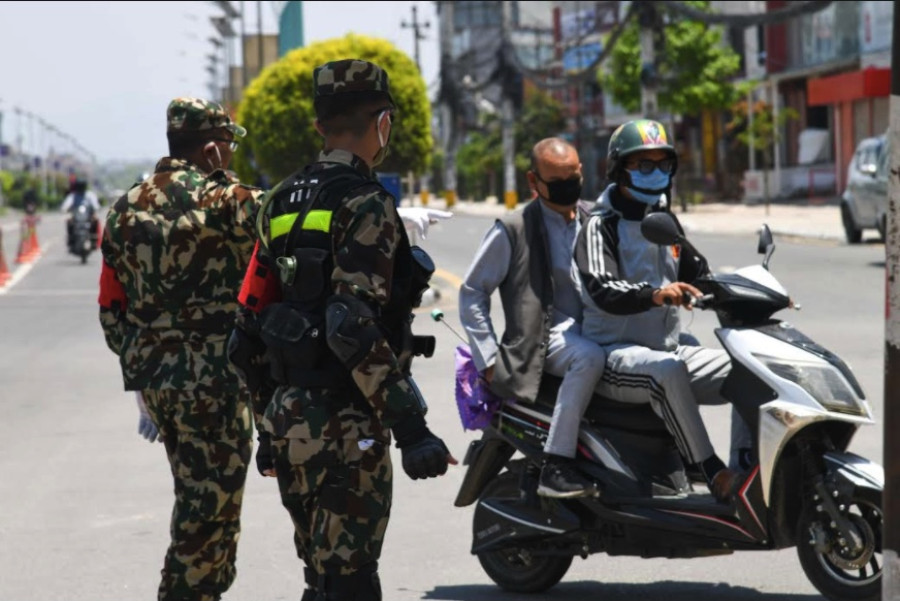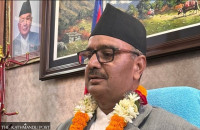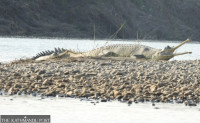National
Nepal Army patrolling the streets raises alarm, leading many to question why the defence force was mobilised
The army says that military police were mobilised to ensure that its uniform is not misused to breach the lockdown, but analysts say it could have sought the help of the Nepal Police.
Binod Ghimire
The Nepal Army has mobilised its military police in four areas of Kathmandu Valley in order to prevent the misuse of its uniform to break the nationwide lockdown, according to the army.
The military police, which is the army’s own law enforcement unit, has been mobilised in New Baneshwor, Thapathali, Kalimati and Maharajgunj, according to Nepal Army spokesperson Brigadier General Bigyan Dev Pandey.
“The military police have been mobilised just to ensure the army uniform is not misused to breach the rules of the lockdown,” Pandey told the Post. “They aren’t for civilian surveillance.”
Military police personnel were already on the streets on Sunday. According to a report in Naya Patrika, a vernacular daily, an elderly man clad in a camouflage shirt similar to that of the Nepal Army was on his way to the blood bank when he was made to remove the shirt by the military police. A front page photo of the man clad only in undershirt being escorted by armed army personnel had elicited much public criticism, with many asking who had authorised the Nepal Army to leave their barracks.
Pandey, the army spokesperson, said that it was saddened by the actions of its personnel and is looking into the matter. Following criticism, military personnel have also stowed their weapons from Monday onwards.
Members of the public and security sector analysts have questioned the need for the army to be out on the streets during a pandemic, saying their armed presence is unwelcome and could even be illegal.
The Nepal Army cannot leave their barracks without prior clearance from the National Security Council, according to the Nepali law. The chief district officer too can seek the army’s support in maintaining order or in case of an emergency, as per the 1971 Local Administration Act.
Janak Raj Dahal, the Kathmandu chief district officer, told the Post that no decision had been taken at the local level to mobilise the army.
“There has been no official decision by the District Security Committee to mobilise the army,” said Dahal, who also heads the committee.
Government officials, however, said that permission is not required for the deployment of military police as they are only surveilling army personnel.
“The security council or local administration needs to take decisions only if the army comes out of its barracks for work that is related to civilians,” Santa Bahadur Sunar, spokesperson for the Ministry of Defence, told the Post.
He said military police are only controlling the unnecessary movement of army personnel, along with the misuse of the uniform and do not have the authority to interrogate civilians, unless they are not misusing the army uniform.
Sunar said military police are outside just to maintain discipline within the force.
Security sector analysts, however, say the army cannot mobilise its personnel without permission from the civilian government.
“The army can only come out of its barracks if the security council or the local administration allows it,” Geja Sharma Wagle, an analyst who often writes on security related matters, told the Post. “There is no other way.”
If its uniform was being misused, the army could have sought support from the Nepal Police instead of mobilising its own personnel, said Wagle.
“Coming out of the barracks on their own cannot be justified on any pretext,” he said.
The political parties, too, have taken issue with the manner in which the Nepal Army mobilised its personnel. Lawmakers from both the ruling party and the opposition said that the army must respect civilian supremacy.
Deepak Prakash Bhatta, a lawmaker from the ruling Nepal Communist Party (NCP) who was involved in the army integration process after the end of the 10-year armed insurgency, said it was wrong for the army to come out to the streets without permission from the civilian authorities.
“The Defence Ministry should be looking into the issue. Otherwise, it can be dealt with at the State Affairs Committee of Parliament,” Bhatta told the Post. He too reiterated Wagle’s point that even if the army feels its uniform has been misused, it should seek help from the Nepal Police.
The opposition Nepali Congress too raised the mobilisation of the army at the federal parliament on Monday. Prakash Man Singh, an opposition lawmaker, said that the army cannot be doing the work of the civilian police.
“We see the army in the streets interrogating the public,” he said. “What is the intention of this government?”
The Ministry of Home Affairs, on August 1 last year, had issued a notice asking civilians to refrain from wearing camouflage that resembles the army’s uniform, following reports that civilians were impersonating army personnel, according to Indrajit Rai, the home minister’s security adviser.
“We also have information that people from different miscreant groups, including those from the Netra Bikram Chand outfit, were entering the Valley using such uniforms,” said Rai. “We have learned that army personnel have been deployed to contain the misuse of its uniform as the police cannot arrest anyone in the army’s uniform.”
Anil Giri contributed reporting.




 10.12°C Kathmandu
10.12°C Kathmandu














